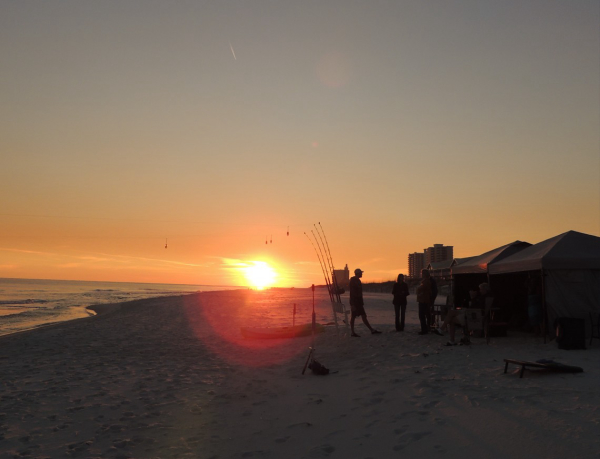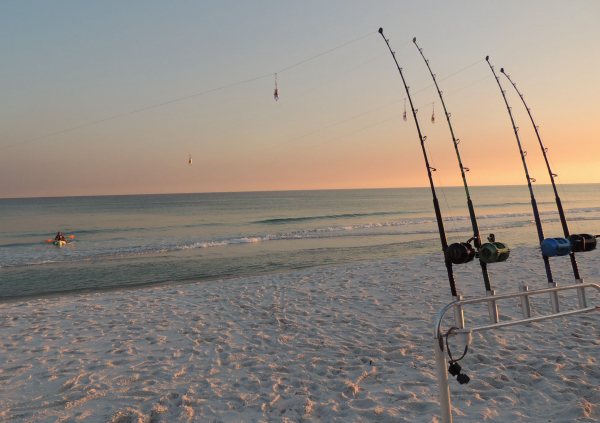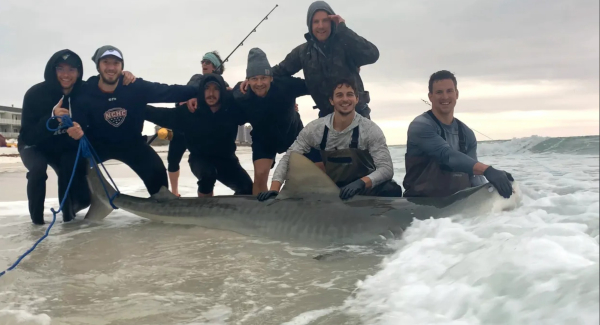
Big John McLean comes by his name honestly—he stands 6’9”, and was for a time the tallest goalie in pro hockey, playing for the Pensacola Ice Flyers. Note this is not the offensive star John MacLean of the New Jersey Devils, who was for a time the biggest guy in the sport in terms of goals scored.
Now, this McLean is the biggest guy in guided shark fishing from the beach.
Though, admittedly, there are not many guiding shark trips from the beach.
Amazingly—and to the chagrin of those who love swimming on the beaches of north Florida—McLean’s trips are remarkably successful.
His anglers have caught makos, hammerheads, duskys, blacktips, bulls, tigers and even a few great whites while standing on the sand. Some of these big eaters approached 14’.
Fortunately, the big boys are not usually anywhere near where beach goers splash around in waist deep water, however.
Using a helper who mans a 10’ kayak, McLean puts out his spread of baits—typically fish heads from the cleaning tables, or jack crevalle of a couple pounds, sometimes small rays—at distances up to 800 yards from the beach, on 10/0 or larger hooks that look like they could pull a Jeep out of the ditch. He also sometimes uses a remote control Aqua Cat bait boat about 3 feet long to haul the baits out.
With the gentle slope of the shore in this area, the water at 800 yards may only be 25’ deep.
Not surprisingly, the tackle is typical big game issue, broomstick rods with roller guides and Avet 80 two-speed lever drag reels capable of holding 1300 yards of 200 pound test braid.
Lights attached to the lines act as strike alerts for after dark trips, though the minute a shark feels the hook the reel starts to howl and there can be no doubt.
The rods go into a custom-built welded aluminum fighting chair where the weight of the angler holds the assembly down on the beach, though for smaller sharks some anglers choose to fight them from a fighting belt around their hips with a shoulder harness to the reel.

Like most big game fishing, monster shark fishing is a game of “hours of boredom punctuated by moments of sheer terror.”
When the bite comes, if it comes, the angler is attached by a very strong line to a wild animal that may be four or five times his or her weight. It is “fun” somewhat in the way that jumping off a very high cliff with a bungee cord attached to your shoulders is fun. Sort of the “omygodwhathaveIgotmyselfinto!” kind of fun.
It is inevitably a long, tough battle requiring plenty of help from the McLean team, but so long as the shark does not run all the line off the reel, the angler usually wins.
When a shark is tired out and in the wash of the surf, one of the very intrepid team wades out to tail rope it and drag it over the nearshore bar to the wash, where it can be photographed. This is a touchy business, to say the least—a very pissed off shark in waist deep water with near zero visibility—what could go wrong?
Fortunately, it all works out somehow. The shark is hauled into knee deep water, the head faced into the waves so that it gets steady water movement through the gills to keep it breathing.
John and his clients quickly get their photos and videos and put a tape on the fish. Most are 8’ and up. Then he goes to work with his hook remover, which not surprisingly is about 3’ long and made of heavy steel bar.

Once the hook is out, the fish is towed back into waist deep water, the rope removed and the shark held upright until it tries to swim on its own, then pushed back toward open water. Release success is near 100%, he says.
For his beach charters, McLean sets up a camp on the beach, complete with tent, lounge chairs, food and drink, lights, heaters and everything it takes to spend a long night waiting for that clicker to go off.
Many shark species are protected in Florida waters, but since all McLean’s catches are released, there’s no issue with the regulation. (A shore-based shark fishing permit is required by the state’s Fish & Wildlife Commission, however. The permit includes a required online course in handling and releasing sharks: https://myfwc.com/fishing/saltwater/recreational/sharks.)
Fortunately, most shark species are most abundant in this area in winter, McLean reports, the time when swimmers—except for a few hardy Minnesotans--are absent. However, he notes that bull sharks do move into the shallows in spring when the baitfish migrations arrive, definitely a time for swimmers to be more alert.
See details at https://bigjohnsharkfishingadventures.com.